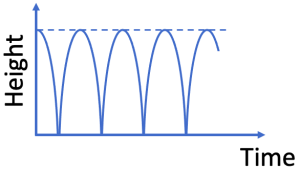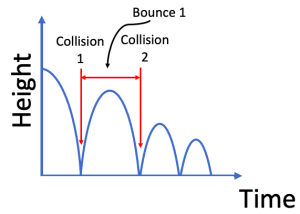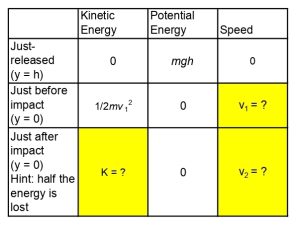Exercise 1: Energy conservation of a bouncing ball
In this lab you will be exploring energy conservation during collisions. You will do this by studying how a ball bounces on different surfaces, and by calculating the energy lost (to sound, to friction, etc.) from each collision with the ground.
In the Conservation of Energy: Warm-up exercise you considered how high a ball would bounce if it was dropped from a certain height. For example, for a perfect elastic collision with the floor and no air resistance, if you were to drop the ball from a height of 1 m, it would bounce back up to a height of 1 m, and all the mechanical energy of the ball would be conserved. So, in this example of a perfectly elastic collision, the ball would bounce back to its initial height, and the kinetic energy of the system (the ball and the floor) is the same before and after the collision.
You will find in the following exercises, that real-life collisions do not conserve all the mechanical energy and they are not perfectly elastic. In Figure 1.1 below, the height as a function of time is shown for a perfectly elastic bouncing system, where the height of the ball always returns to the initial height of the drop. Note: While the ball is in the air, we are ignoring air resistance; we are assuming zero energy loss.

Figure 1.1 is not realistic and not exactly what you will see in your experiments. Your experimental results will show that the time between bounces gets smaller and the maximum height reduces with each bounce. The collisions with the ground are not perfectly elastic. This is shown in Figure 1.2 below.

The goal of the following experiments is to determine how elastic each bounce is. You can accomplish this by calculating the maximum height of a ball (potential energy) on multiple bounces and from this height, calculate the speed (kinetic energy) the ball left the surface with.
Unfortunately, measuring the height of successive bounces and maximum velocities is difficult (yes, you could do it using the video method you used in Lab 1, but it would be really tedious). Instead, you will do it by measuring the time between collisions on an audio track.
If an object leaves the ground with a speed v0 and is only under the influence of gravity (no air resistance), you can calculate how long it will be in the air until it reaches the ground again.
Exercise 1.1 (1 mark)
In the following scenario, assume half of the mechanical energy is lost during a bounce. Consider the moment just before the ball collides with the ground and the moment just after the ball leaves the ground. Pick the correct option(s) for K, v1, and v2 on Crowdmark.

Exercise 1.2 (1 mark)
Use the following kinematic equation to derive an equation that tells you how long the ball is in the air, Δt, if it left the ground with a speed [latex]v_0[/latex] straight up, and returned to the ground with the same speed [latex]v_0[/latex]:
[latex]\Delta y = v_0\Delta t + \frac{1}{2}a\Delta t^2[/latex]
Helpful hint: Remember, we have defined the ground as y = 0 m (which is both the initial and final position). Assume up is positive so that the acceleration due to gravity is a = -g where g = 9.8 m/s2.
Pick the correct answer(s) directly on Crowdmark.
Exercise 1.3 (1 mark)
Consider the following scenario: A ball is bounced off the ground, goes straight up into the air, and falls back down to the ground. It is in the air for a time Δt. Use the following kinematic equation to derive an equation that tells you the speed [latex]v_0[/latex] that a ball leaves the ground with:
[latex]\Delta y = v_0\Delta t + \frac{1}{2}a\Delta t^2[/latex]
Helpful hint: Remember, we have defined the ground as y = 0 m (which is both the initial and final position). Assume up is positive so that the acceleration due to gravity is a = -g where g = 9.8 m/s2.
Pick the correct answer(s) directly on Crowdmark.
The equations you derived tell you how long the ball is in the air based on its speed as it leaves the ground. In other words, if you know the time the ball is in the air between collisions, you can determine the speed the ball left the ground with. Of course, if you know the speed, you also know how much kinetic energy it had as it left the ground.
Before you continue!
Before continuing, be sure you have completed Exercises 1.1-1.3 which will be graded and submitted through Crowdmark.

